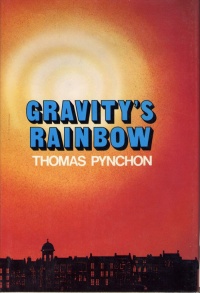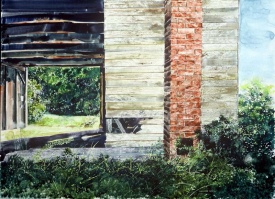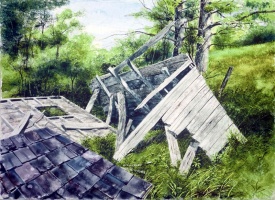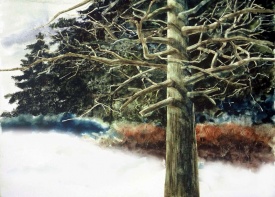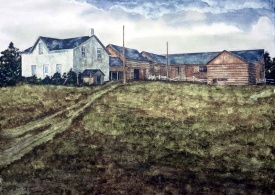Difference between revisions of "Marc Getter - Designer and Artist"
| (8 intermediate revisions by the same user not shown) | |||
| Line 1: | Line 1: | ||
by Linda Getter, Marc's Wife | by Linda Getter, Marc's Wife | ||
| − | [[image:marc-getter_sketching.jpg|left|thumb|300px|caption|Marc Getter, Early 1970s, NYC]]<p class="normal"> | + | [[image:marc-getter_sketching.jpg|left|thumb|300px|caption|Marc Getter, Early 1970s, NYC]] '''Some Biography'''<p class="normal">Marc was born on July 17, 1947 in the Bronx. He formally studied at City College of New York, but he learned art at his father’s knee. Herman Getter was an exquisite painter who taught for 37 years at both Taft High School and Baruch College in New York. Herman had a studio and small art gallery in Peekskill, New York, where the family spent summers. For many years Marc spent his summers painting with his father.</p> |
| − | <p class="normal"> | + | '''''Gravity's Rainbow'''''<p class="normal">In December 1981, my soon-to-be husband and I were at a Christmas party in a New York City loft. He was bored and began scouting the bookcases, took down a book and handed it to me. “I did the cover for this.” By “did” he meant had designed and illustrated the cover. The book was ''Gravity’s Rainbow'', Thomas Pynchon’s third novel, published by The Viking Press in 1973. The cover featured an airbrushed sun above a black silhouetted cityscape.</p> |
| − | <p class="normal"> | + | <p class="normal"> |
| + | [[image:gravitys-rainbow-cover.jpg|right|thumb|200px|caption|''Gravity's Rainbow'' Cover, Marc Getter]]When Marc Getter worked on the cover in 1972 he was 25 years old and both the airbrushing and the city silhouette were typical of the way he saw the world and, certainly, the book. Soft rounded images that bleed into the background, and strong sharp lines that delineated reality. He was at a small agency that specialized in book covers, and he loved the idea of a single image being responsible for communicating the essence of a book. The airbrush let him do that.</p> | ||
| − | + | '''Watercolor'''<p class="normal">The airbrush, a device that creates a narrow spray of color driven by a hand-operated compressor, was still a staple in his home when I arrived in 1981. He was attached to it. In college he had experimented with fine art using the airbrush. His work won him an honorary membership to the (British) Royal Society of Art in 1967, and confirmation as a lifetime member in that Society in 1969. Airbrushing with its soft edges and broad colors was something that had fascinated him from the time he began painting in his teens.</p> | |
| − | + | [[image:Marc-Linda-Getter.jpg|left|thumb|300px|caption|Marc and Linda Getter, NYC]]The device was perfect for watercolors, and watercolor, with its quick strokes and illusory statements, was exactly what Marc loved. Watercolors are somewhat unforgiving. They don’t accept correction well as oils do with their slick surface and long drying time. In his early watercolors Marc’s strokes were immediate and powerful. His abstract airbrushed paintings could be light with expectation or dark with menace. For Marc the airbrush was the perfect tool for expressing immediate emotion. | |
| − | + | <p class="normal">'''Experiments with Oil and Acrylic'''<br />Later, in the early 1980s Marc briefly (very briefly) experimented with oil and acrylic, but quickly discovered oils and acrylics, which allow artists strong color and control, didn’t work well for him. The “drag” on the brush killed him. It took too long and was too tempered for the quick, decisive strokes that made his watercolors both bold and a bit otherworldly.</p> | |
| + | |||
| − | Marc died in March of 2008. I have every scratching, painting, sketch, study and doodle he left behind. Here are a few of Marc’s later paintings – a world away from the airbrushed watercolor of ''Gravity’s Rainbow''. | + | <p>'''Back to Watercolor, to Stay'''<br /> |
| + | With this brief experimentation in other media, he turned from abstract to representational painting, which served him well for the rest of his life. In 1990 he began working with archival art board, a paper alternative with a glass-like surface that did not absorb the paint but left it malleable on the surface – and lots of “tools.” Tools were old stiple brushes, crumbled paper towels, sponges that helped create an almost (but not quite) photorealistic effect on the art board. The result was a series of large watercolors, all featuring stands of trees or wooden structures executed in precise fine lines.</p> | ||
| + | |||
| + | '''Marc's Passing'''<br /> | ||
| + | Marc died in March of 2008. | ||
| + | |||
| + | '''Marc's Watercolor Paintings'''<br /> | ||
| + | I have every scratching, painting, sketch, study and doodle he left behind. Here are a few of Marc’s later paintings – a world away from the airbrushed watercolor of ''Gravity’s Rainbow''. | ||
<table> | <table> | ||
Latest revision as of 15:09, 5 December 2011
by Linda Getter, Marc's Wife
Some BiographyMarc was born on July 17, 1947 in the Bronx. He formally studied at City College of New York, but he learned art at his father’s knee. Herman Getter was an exquisite painter who taught for 37 years at both Taft High School and Baruch College in New York. Herman had a studio and small art gallery in Peekskill, New York, where the family spent summers. For many years Marc spent his summers painting with his father.
Gravity's RainbowIn December 1981, my soon-to-be husband and I were at a Christmas party in a New York City loft. He was bored and began scouting the bookcases, took down a book and handed it to me. “I did the cover for this.” By “did” he meant had designed and illustrated the cover. The book was Gravity’s Rainbow, Thomas Pynchon’s third novel, published by The Viking Press in 1973. The cover featured an airbrushed sun above a black silhouetted cityscape.
When Marc Getter worked on the cover in 1972 he was 25 years old and both the airbrushing and the city silhouette were typical of the way he saw the world and, certainly, the book. Soft rounded images that bleed into the background, and strong sharp lines that delineated reality. He was at a small agency that specialized in book covers, and he loved the idea of a single image being responsible for communicating the essence of a book. The airbrush let him do that. Watercolor
The airbrush, a device that creates a narrow spray of color driven by a hand-operated compressor, was still a staple in his home when I arrived in 1981. He was attached to it. In college he had experimented with fine art using the airbrush. His work won him an honorary membership to the (British) Royal Society of Art in 1967, and confirmation as a lifetime member in that Society in 1969. Airbrushing with its soft edges and broad colors was something that had fascinated him from the time he began painting in his teens.
The device was perfect for watercolors, and watercolor, with its quick strokes and illusory statements, was exactly what Marc loved. Watercolors are somewhat unforgiving. They don’t accept correction well as oils do with their slick surface and long drying time. In his early watercolors Marc’s strokes were immediate and powerful. His abstract airbrushed paintings could be light with expectation or dark with menace. For Marc the airbrush was the perfect tool for expressing immediate emotion.Experiments with Oil and Acrylic
Later, in the early 1980s Marc briefly (very briefly) experimented with oil and acrylic, but quickly discovered oils and acrylics, which allow artists strong color and control, didn’t work well for him. The “drag” on the brush killed him. It took too long and was too tempered for the quick, decisive strokes that made his watercolors both bold and a bit otherworldly.
Back to Watercolor, to Stay
With this brief experimentation in other media, he turned from abstract to representational painting, which served him well for the rest of his life. In 1990 he began working with archival art board, a paper alternative with a glass-like surface that did not absorb the paint but left it malleable on the surface – and lots of “tools.” Tools were old stiple brushes, crumbled paper towels, sponges that helped create an almost (but not quite) photorealistic effect on the art board. The result was a series of large watercolors, all featuring stands of trees or wooden structures executed in precise fine lines.
Marc's Passing
Marc died in March of 2008.
Marc's Watercolor Paintings
I have every scratching, painting, sketch, study and doodle he left behind. Here are a few of Marc’s later paintings – a world away from the airbrushed watercolor of Gravity’s Rainbow.

